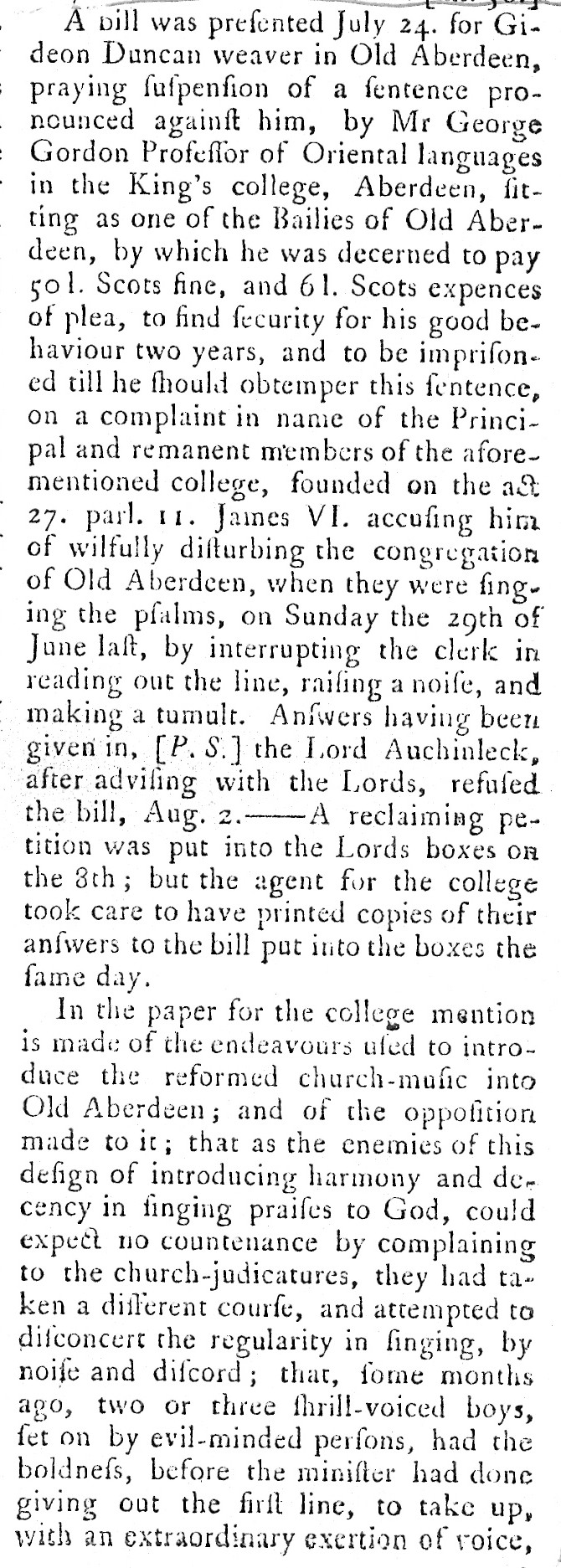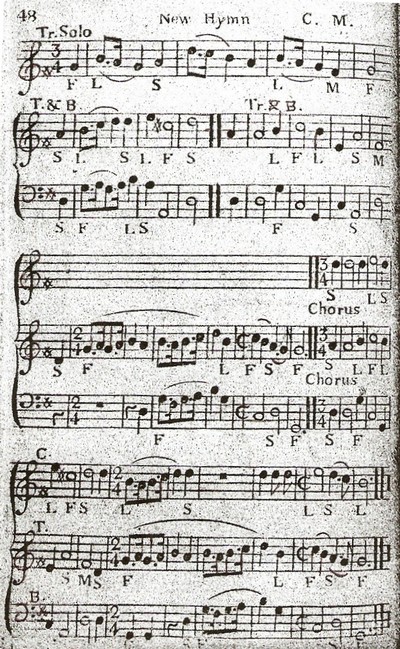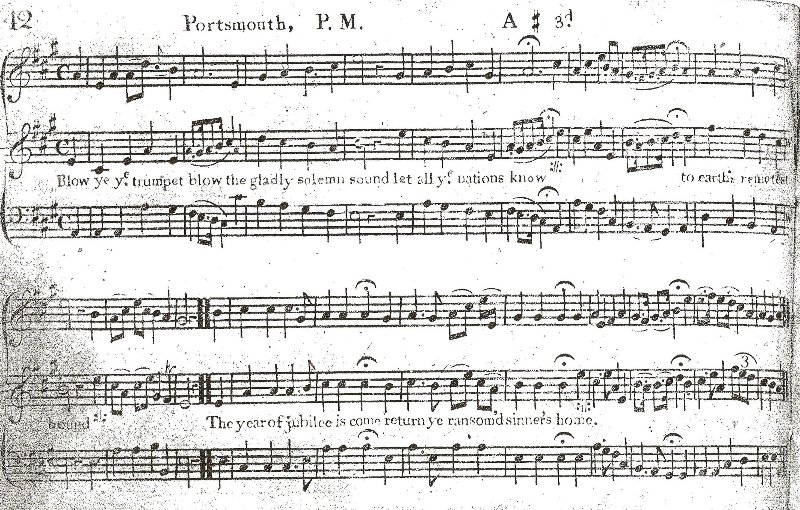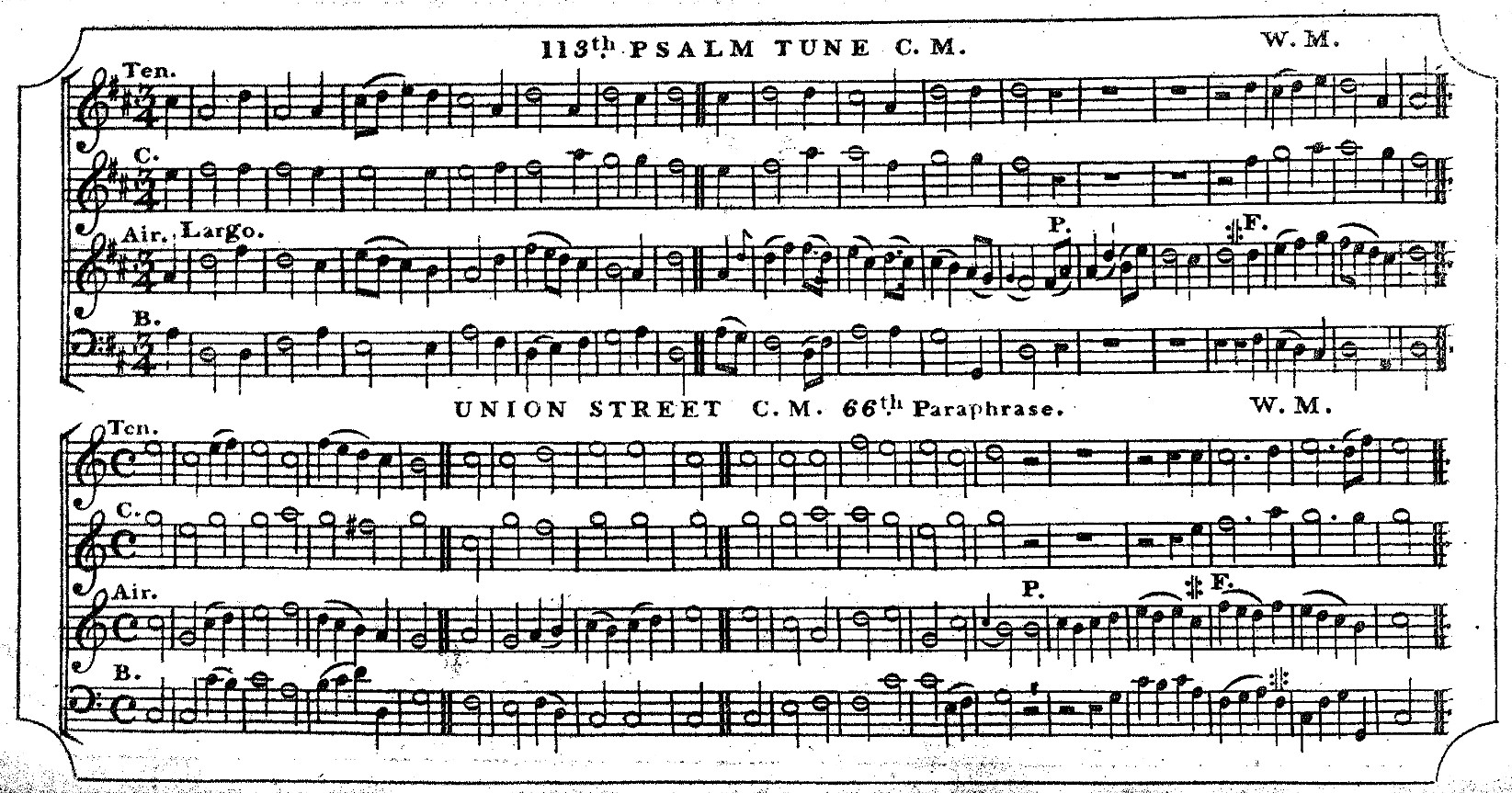|
Gallery Psalmody in Scottish Kirks
David Welch
Revised from an article in Different Voices, Issue 3, May 2009.
This article tells about the music of Presbyterian churches in Scotland between the closing of the era of the "Twelve Tunes" around 1755 and the coming of hymns and organs in the second half of the nineteenth century. The singing during this 100-to-120-year period was unaccompanied, led by a precentor. Often the leading singers were grouped in a choir and allocated a loft, hence the term Gallery Psalmody. Instruments were forbidden, and even the use of pitch-pipes to give a starting note was criticised in the early years of the period.
The Twelve Tunes are often talked about to show the poverty of kirk singing in the early eighteenth century. But these were the tunes for Common Metre psalms, and for psalms in other metres some extra tunes were in use. A deeper problem was the slow speed of the singing and its excessive ornamentation by "quavering", which obscured the tunes' character and shape. So pressures mounted for reform.
In the lead was Sir Archibald Grant, a landowner at Monymusk in NE Scotland who made many advances in agriculture, forestry and gardening. In 1746 he asked for a choir to be formed in his local kirk, then argued for plain and faster singing, and in 1753 invited to train the choir a soldier stationed in Aberdeen who was skilled in the English West Gallery style. Details of the “Monymusk Revival” are given in another article Church Music in NE Scotland in the Eighteenth and Nineteenth Centuries on this site.
The new choirs sang in harmony, usually three-part in the early years, and the parts had solo sections in many tunes, often with staggered and fugal entries. Dotted notes were a feature, giving bounce, and some tunes had changes in rhythm, from 3-time to 4-time or vice versa.
The new style soon spread. In Aberdeen there was famously opposition in 1755 from the session of the main St Nicholas Kirk, and also Gideon Duncan in the Old Town (1). But the reformers won, as reported in the Scots Magazine later that year (2). Edinburgh and Glasgow at once followed, both cities bringing in English singing teachers in 1755, respectively Cornforth Gilson from Durham Cathedral choir and Thomas Moore from Manchester.

Fig.1. Part of an article in the Scots Magazine of July 1755 telling of the appeal of Gideon Duncan to the High Court in Edinburgh against his being fined £50 Scots for disrupting the new-style psalmody in the kirk of Old Aberdeen, now St Machar`s Cathedral.
The musical reformation was spurred on by the burgh councils and heritors (local landowners) who ran kirk affairs, paying for singing lofts and the choir training. Aspiring choristers went to regular classes and had to learn the notes for their own parts from books that they were sold or given.
In Glasgow, Moore produced a short psalmody in 1756, The Psalm-singer`s Pocket Companion, containing 30 simple tunes and tutorial instructions (3), and then a longer one in 1762, The Psalm-singer`s Delightful Companion. This contained 74 tunes including some that were more elaborate, and 7 canons; clearly Moore`s teaching had been successful. For Edinburgh several different psalmodies were published from 1756 to 1762 (4). For the North East no psalmody from this early period is yet known, and our knowledge of the repertoire comes from a table of tunes printed in the Scots Magazine (this is reproduced in the Church Music in NE Scotland article).
The new choirs were quite large: the Scots Magazine recorded that the choir from Monymusk that demonstrated the new style in Aberdeen in January 1755 contained
18 bass, 30 tenor (5 being counters for 4-part tunes), and 22 female voices. And for Kintore nearby the new loft, which the Earl of Kintore erected in 1754 and gave free to those taught to sing, "contained about 120 people and had greatly slacken'd the body of the church".
Once the new style was established, the repertoire steadily increased, both musically as shown by tune lists, and textually. A first set of 45 paraphrases had been issued in Scotland in 1745, and we know that Sir Archibald Grant bought 100 copies of the stitched paraphrases at 2½d each in 1754. A few hymns were appended to the second batch of 67 paraphrases published in 1781, and other material was worked into services as dismissions, doxologies and sanctuses.
The tune New Hymn shows several features of the style including changes of rhythm and solo passages for different parts; it was included in Moore`s 1756 and 1762 psalmodies along with several hymns, and we have set it to "When all thy mercies O my God", which was Hymn 1 in the 1781 publication. But as well as the more elaborate tunes there were many simple tunes in use, such as Glasgow which has dotted rhythms, and French and St Paul, plain 4-time tunes that have remained popular up to the present century.

Fig. 2. "New Hymn" in Moore`s 1762 Psalm-singer`s Delightful Pocket Companion.
Click on picture to hear it sung.
The scale of musical activity and the skill of the musicians in the Gallery Psalmody era in Scotland will surprise many today. The Hymn Tune Index (HTI) developed by Nicholas Temperley and meantime extending up to 1820, catalogues 155 Scottish psalmodies, 122 of them appearing after 1755.
[Gilmour, Robert, of Paisley, Renfrewshire]. The Psalm-Singer’s Assistant ... Adapted to the Psalms of David, and the Assembly’s Translations.
Glasgow: A. Macgoun, [1791–3]. 68p.; upright; engraved. GB-En: Cwn. 318. 46 tunes (–3–4).
No earlier than 1791, as it calls a tune ‘Dr. Arnold’s’, taken from ArnoSPD, which was published that year. The compiler’s identity is revealed in ed. 2. ‘The Assembly’s Translations’ refers to Translations and Paraphrases (Edinburgh, 1767): see note to *SCT D a.
Brown, William, of Glasgow. The Precentor ... With a choice collection of psalm tunes ... suited to the ... version of the psalms used in the Church of Scotland.
Ed.6. Glasgow: The author, 1799. 48p.; upright; engraved. GB-En: Cwn. 111. 40 tunes (–4).
An edition of FinlRP. Brown was ‘teacher of vocal music in Glasgow’ and precentor of the Wynd Church (Love, p. 317).
Fig. 3. Entries in the Hymn Tune Index giving details of two West Scotland psalmodies; the GB code gives the library which holds the exemplar, and the -3-4 code tells that the tunes were laid out in 3 and 4 parts.
Psalmodies were published mostly by precentors or singing masters who travelled around taking classes on weekday evenings and before or after services. Even some small places had a singing master, e.g. in NE Scotland John Sivewright operated successively at Auchenblae, Turriff and Old Deer, before ending his career as precentor for the kirk in Old Meldrum (see the Church Music in NE Scotland article). The move to each new district doubtless gave him new students and more sales. His little psalmodies contained good-quality music, the edition published at Old Deer c. 1810 containing several anthems and 82 tunes, some quite elaborate. And there was even a pirate edition sold in Edinburgh, as we know from John`s angry notice in an Aberdeen newspaper.

Fig. 4. 'Portsmouth' in A Collection of Psalm Tunes Hymns & Anthems published by John Sivewright c.1810.
In total around 1000 different tunes had been published somewhere in Scotland up to 1820, and many more were added up to 1840. Prof. Temperley has now started a long-term project to extend the HTI up to 1840, so I am hunting for psalmodies from the 1821-1840 period and already about 50 are known. Often the publishers added extra tunes in further editions, discarding others, but sorting this out can be difficult since many psalmodies are undated and the editions unnumbered.
Some church musicians claim that not all the tunes in psalmodies were actually used in services, suggesting some elaborate tunes were included for home singing, or as vanity exercises by compilers trying to spread own compositions. But we do have accounts that tell of particular tunes being sung, e.g. an 1876 book on Aberdeen churches recalls that in Trinity Kirk the precentor from 1815 to 1844 used tunes with long bass solos such as Missionary and New Henley, and "the heavy bass voices as they came rolling down from that remote end gallery will not be forgotten"; a Glasgow psalmody underlies words for the bass entry in New Henley "then shall we sing in joyful strains", with plenty of tied quavers on "sing" and "joy".
But this singing has been forgotten, with just a few fairly plain Gallery tunes remaining in present-day Scottish hymn books, examples being Adeste Fideles, Diadem and Lyngham. The Victorians thought these tunes florid and vulgar; they sought refined and much slower singing, and the variety given by the different parts singing alone or in combinations came instead from the new colours provided by organs.
Scottish composers of sacred music published a considerable number of tunes, but their compositions were outnumbered by imports from England in most tune-books. Evaluation of the talents of the Scots composers is hard since what is now known of their work is meagre and untypical. Several who featured in the Gallery psalmodies are represented in the latest Scottish Presbyterian hymnbook (Church Hymnary 4) by just one or two tunes, as shown in Fig. 5. Perhaps Robert Archibald Smith was the best, composing some attractive, interesting tunes and doxologies.
John Campbell
Neil Dougall
Charles Hutcheson
Robert Simpson
Robert Archibald Smith
Andrew Thomson
Hugh Wilson |
|
Orlington
Kilmarnock
Stracathro
Ballerma
Invocation
St George's Edinburgh
Martyrdom |
Fig. 5. Scots composers in the Gallery Psalmody era, and their surviving tunes in Church Hymnary 4.
Many more Scottish composers have no tunes in the current church repertoire, one such being William Maitland who was precentor of the Aberdeen East Kirk. He published a fine tune collection in 1823, the Aberdeen Psalmody, which was intended chiefly for this congregation, as stated in small writing on the title page (shown in the Church Music in NE Scotland article). Maitland's two tunes reproduced in Fig. 6 are typical of the early nineteenth century in being four-part, and in having a quiet penultimate line repeated loudly at the end.

Fig. 6. '113th Psalm Tune' and 'Union Street' composed by William Maitland (WM), and published in Aberdeen Psalmody (1823).
In Scotland no revival quires singing Gallery Psalmody have yet been established, and only very limited Sacred Harp singing takes place. But interest in the music of this era is growing, with occasional workshops and performances to accompany talks. I believe some of the Scottish tunes are well worth reviving, and just like the past changes in musical style in Scotland following events in England, so there will soon be a resurrection of Gallery psalmody in Scotland that parallels the West Gallery movement on England.
References:
1. Scots Magazine July 1755, pp. 359-362. back
2. Scots Magazine October 1755, p. 512. back
3. Welch, D. (2004) Thomas Moore's Pocket and Delightful Companions. West Gallery 29: 13-14. back
4. These were compiled by Robert Bremner (several editions), Cornforth Gilson and W. Gray. back

|